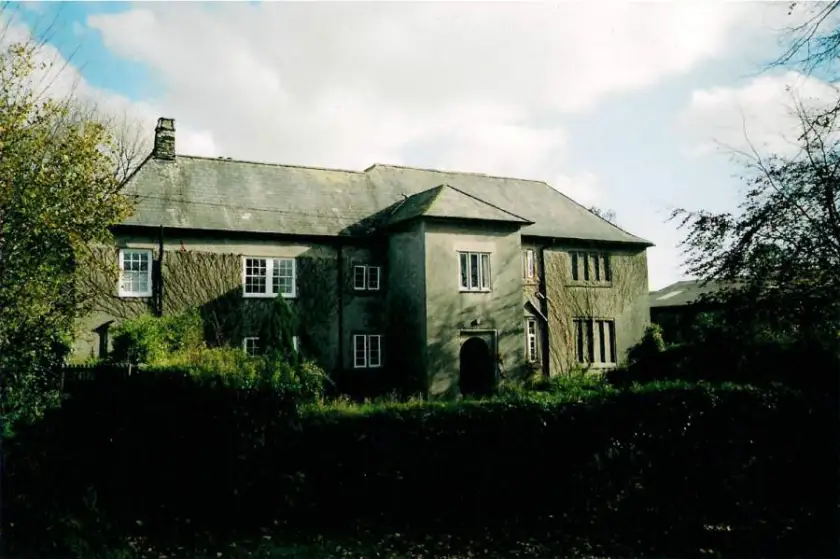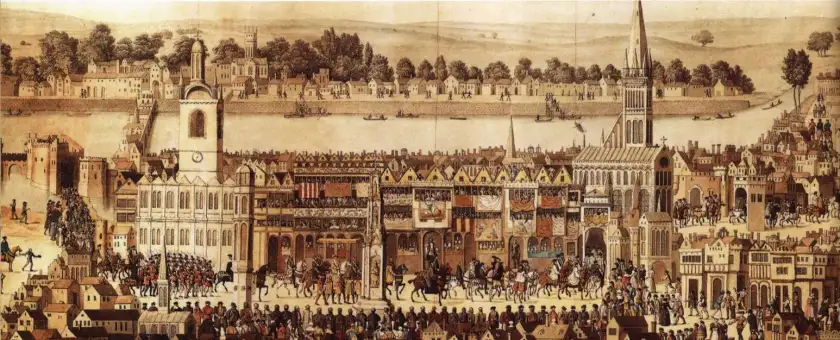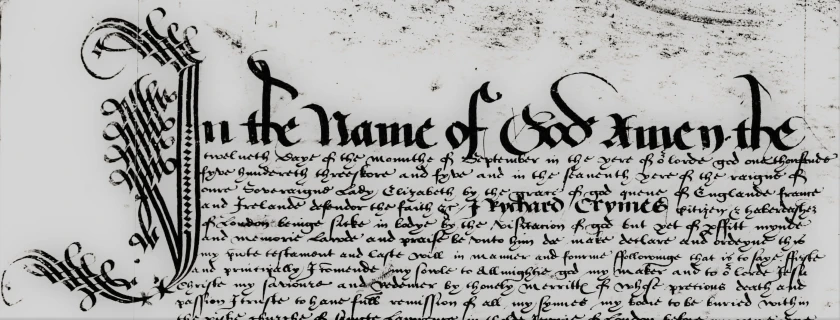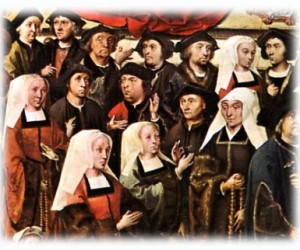[The following is an updated and revised edition of an ancestor sketch I wrote back in 2010.]
Plugging an ancestor into his or her time period, discovering how they fit in not just where they lived, but when they lived, and tying the narrative of their lives to broader historical context is among the ultimate accomplishments of a dedicated family historian. The greatest challenge is usually finding enough information about an ancestor to make him or her more than just a name on a pedigree in the first place.
In my husband’s case, he’s lucky enough to have a twelfth great-grandfather who left a paper trail all over sixteenth century London.
One of earliest appearances of Richard Crymes, haberdasher in the historical record dates to 1534, the year the Church of England officially broke with Rome, not long after Henry VIII’s marriage to Anne Boleyn and the birth of Elizabeth I. The king granted a few properties around London to Richard and two others, including John Crymes, a clothworker1 and probable relative. Because Richard was old enough to have a profession and own property by 1534, it’s likely he was born sometime between 1500 and 1515, towards the end of or just after the reign of Henry VII, around the beginning of the Protestant Reformation.
Richard was a member of the Worshipful Company of Haberdashers, one of the Great Twelve Livery Companies of London, which were descended from the earlier medieval trade guilds. In the sixteenth century, London’s livery companies were centers of economic, social, and political power for upper class commoners. They regulated commerce within their given industries, and membership in a livery company carried with it the freedom of the city–that is, freedom from serfdom, and the freedom to trade and own property. Freeman status by way of a livery company could be achieved via apprenticeship, patrimony, or redemption (buying your way in). Which route Richard took is unknown, but by the 1530s he was a Master Haberdasher. In 1535, Richard’s apprentice John Mucklow became a freeman.2
Haberdasheries in the United States today (when they exist outside department stores, which is rare) primarily sell men’s clothing and accessories; shirts, tie clips, and collar stays, etc. But in Tudor England, haberdashers were purveyors of small wares, from sewing supplies to fashion accessories to knick-knacks. Haberdasheries in Richard’s day were extravagant businesses, often brightly and fabulously decorated, over the top and ostentatious enough to encourage customers to part with their money.3
And part with their money they apparently did, because Richard was an extraordinarily wealthy commoner for his time. In 1541 he paid more in lay subsidies (taxes) than anyone else in his entire parish (St. Lawrence in the Cheap ward).4 Richard was wealthy, and he leveraged that wealth to accumulate quite a lot of property, thanks in part to the availability of former monastic lands confiscated by Henry VIII in his power struggle against the Pope.
In April 1546, Richard and his wife Elizabeth purchased a manor in Buckland Monachorum in West Devon for about £1500.5 Buckland was the site of a former Cistercian abbey seized by the crown as a result the Dissolution of the Lesser Monasteries Act in 1535. The lands Richard purchased originally belonged to the Abbey, but abbey and the manor were separated by the dissolution. Richard built a manor house on the land6 and called it Crapstone Barton. The house still stands to this day, thanks in part to its status as a Grade II* Historic England listed building, although it was almost completely rebuilt in the early seventeenth century7 and has long since been sold out of the family.

Richard purchased more seized church properties, in Sileby and Lubenham in Leicester, in October of 1546,8 a scant few months before the death of Henry VIII and the coronation of boy-King Edward VI.
Like most coronations, Edward VI’s coronation in February 1547 was a grand affair. Thanks to his status as a Master Haberdasher, Richard would have had a greater ceremonial role in the proceedings than a commoner of lesser economic status. The livery companies were an integral part of London’s political pageantry: from their ranks the aldermen were nominated, and from the alderman’s ranks came the Lord Mayor. As such, the Lord Mayor was then (and is now) a member of one of the livery companies. When Anne Boleyn was conveyed up the Thames for her coronation in 1533, the Lord Mayor at the time was, like Richard, a haberdasher. The company was charged with organizing a flotilla which was to collect the Queen from the palace at Greenwich, and escort her by water to the Tower of London to rest before processing through the city to Westminster Abbey. All of the livery companies participated in the barge parade, including the haberdashers, who followed just behind the Lord Mayor.9 There’s (probably) no way to know for certain whether Richard was aboard the haberdashers’ barge that day, but it’s certainly possible. Likely, even.
As for Henry VIII’s funeral and Edward VI’s coronation in 1547, Richard’s status among the livery men was high enough that he was nominated for alderman the very next year (although the nomination was rejected).10 He would almost certainly have been among the livery company men lining the streets for Edward VI’s coronation processional.11 At the very least, Richard would almost certainly have given money to fund the haberdashers’ contribution to the many tableaux and pageants which dotted the route to entertain the Boy King.

Another apprentice, John Hewes, became a freeman in 1549.12 July of 1552 saw Richard’s eldest son Ellis married to Agnes (or Anne) Prideaux on the third,13 and Richard’s wife Elizabeth buried on the eleventh.14 Both the marriage and the burial took place at St. Lawrence Jewry, which was then (and still is now) a few block’s walk from the haberdasher’s guild hall.15
A year later, in July of 1553, Edward VI died. The ill-fated teenager Lady Jane Grey was proclaimed (by some) the Queen of England and locked up in the Tower of London for the entire duration of her nine (or thirteen) days “reign,” which ended when Mary I rode triumphantly into London with a large retinue of supporters to legally ascend the throne, another citywide celebration in which Richard most likely played a small ceremonial role in terms of representing his guild as its members lined the streets, clad in the livery of their respective companies, to greet the new Queen.16
A third apprentice of Richard’s, John Tarleton, became a freeman in 1557,17 the year before yet another monarch ascended the throne: the great Elizabeth I, whose coronation would be the last of Richard’s lifetime, and the last for which he most likely turned out in his haberdasher’s livery to greet the the latest new monarch as she processed through the streets to her coronation.
When Richard Crymes died in mid-September, 1565, in the seventh year of Elizabeth I’s reign, he left behind a lengthy will. Lucky for his many, many descendants, the 453 year-old document survives to this day, in the National Archives of the United Kingdom.18

Richard asked to be buried next to his pew door at St. Lawrence Jewry19 (and he was, on 21 September 156520). He left the manor in Buckland Monachorum to his eldest son Ellis, the properties in Sileby and Lubenham to his second son Thomas, and properties in Islington to his daughter Mary. He left a small sum to be divided among his kindred near Witton, in Cheshire (where he was likely born) as well as funds for the maintenance and repair of a local bridge. He willed money to the Queen’s highway fund, put £300 in trust for his granddaughter (forfeit if she married without family approval), left £40 for each of his three grandsons by Ellis, and he made provisions to provide charcoal for the poor folks in his parish and elsewhere. He forgave his debtors, left a few small sums to his friends, and a few big sums to his children; £800 to Mary and £1000 to Thomas.21
Richard spent the entire final paragraph of his last will and testament decrying having been found guilty of pilfering from a casket (in this case a chest or box, not a funeral casket) of 500 pounds in gold which had belonged to a John Prideaux, but was allegedly left in Richard’s custody. In front of witnesses including his old apprentice John Hewes and his daughter-in-law Agnes (Prideaux) Crymes, Richard swore on his deathbed that he’d never had possession of the chest or money, and that he had been falsely accused and convicted.22
“And also doe proteste that I had not the custodie of the saide Caskett nor of any golde of the saide John Pridaiux at any tyme within a yere before his death as I shall answere before god at the dreadfull Daye of Judgemente, and I take it uppon my consciens that I was in that matter moste wrongfully condempued, and that the verditt of the same Jewrye is moste false and untrue And as this whiche I doe declare uppon my death bedde is moste juste and true soe I beseach god my sowle may be saved and not otherwise” – Richard Crymes, as transcribed by Kathy Wiegel23
A cursory search of the United Kingdom National Archives’ online catalog reveals a number of court documents involving Richard as both plaintiff and defendant, largely to do with property disputes or the collection of various debts either owed to or owed by him.24 Most of these documents are not available digitally, so I suppose I’ll have to just…go to England to look at them one day.
Richard lived to see the reigns of five English monarchs (six, if you count poor Jane Grey), from the waning years of Henry VII to the early years of Elizabeth I–and, living in London, he had a front row seat to one of the most dramatic eras in British history. He was wealthy, generous in death, and clearly a shrewd (perhaps even cutthroat, if the court records are any potential indication) businessman, leaving behind a sizable fortune upon his death. His life blazed a paper trail long enough that this lengthy sketch only just scratches the surface. Richard’s descendants would go on to become haberdashers, country gentlemen, knighted members of the House of Commons, and, eventually, an immigrant to colonial Virginia. But that’s a story for another day.
1. James Gairdner, ed., Letters and Papers, Foreign and Domestic, Henry VIII, Volume 7, 1534 (London: Her Majesty’s Stationery Office, 1883), 560; digital images, British History Online, “Henry VIII: November 1534, 26-30” (http://www.british-history.ac.uk/letters-papers-hen8/vol7/pp550-560 : accessed 18 February 2018).↩
2. Worshipful Company of Haberdashers (London, England), “Register of Freedom Admissions 1526-1613,” not paginated, entry for John Mucklow, 1535; digital images, “City Of London, Haberdashers, Apprentices And Freemen 1526-1933,” Find My Past (https://search.findmypast.com/search-world-Records/city-of-london-haberdashers-apprentices-and-freemen-1526-1933 : accessed 18 February 2018); citing CLC/L/HA/C/007/MS15857/001, Registers of freedom admissions, Membership Records, Worshipful Company of Haberdashers, London Metropolitan Archive, England. ↩
3. Thomas Allen, The History and Antiquities of London, Westminster, Southwark, and Other Parts Adjacent, Volume 2 (London: George Virtue, 1839), 363-365; digital images, Google Books (https://books.google.com/books?id=rKsVAAAAYAAJ : accessed 19 February 2018).↩
4. R.G. Land, ed., Two Tudor Subsidy Rolls for the City of London, 1541 and 1582 (London: London Record Society, 1993), 45-49; transcript, “1541 London Subsidy roll: Cheap Ward,” British History Online (http://www.british-history.ac.uk/london-record-soc/vol29/pp45-49 : accessed 18 February 2018); citing E 179/144/120, Exchequer: King’s Remembrancer: Particulars of Account and other records relating to Lay and Clerical Taxation, Records of the King’s Remembrancer, Records of the Exchequer, and its related bodies, with those of the Office of First Fruits and Tenths, and the Court of Augmentations, The National Archives, Kew, England.↩
5. James Gairdner and R H Brodie, eds., Letters and Papers, Foreign and Domestic, Henry VIII, Volume 21 Part 1, January-August 1546 (London: His Majesty’s Stationery Office, 1908), 352; transcript with digital images, “Henry VIII: April 1546, 26-30,” British History Online (http://www.british-history.ac.uk/letters-papers-hen8/vol21/no1/pp334-359 : accessed February 18, 2018).↩
6. Sir William Pole, Collections Towards a Description of the County of Devon (London: J. Nichols, 1791), 337; digital images, Google Books (https://books.google.com/books?id=WF4OAAAAQAAJ : accessed 19 February 2018).]↩
7. “CRAPSTONE BARTON, INCLUDING GARDEN WALL AND GATE PIERS IMMEDIATELY TO WEST OF HOUSE,” Historic England, National Heritage List for England (https://historicengland.org.uk/listing/the-list/list-entry/1105460 : accessed 25 February 2018).↩
8. James Gairdner and R H Brodie, eds., Letters and Papers, Foreign and Domestic, Henry VIII, Volume 21 Part 2, September 1546-January 1547 (London: His Majesty’s Stationery Office, 1910), 161-162; transcript with digital images, “Henry VIII: October 1546, 21-31,” British History Online (http://www.british-history.ac.uk/letters-papers-hen8/vol21/no2/pp138-168 : accessed February 18, 2018).↩
9. Edward Hall, Hall’s Chronicle (London: Printed for J. Johnson, etc, 1809), 798-799; digital images, Archive.org (https://archive.org/details/hallschronicleco00halluoft : accessed 21 February 2018).↩
10. Alfred B. Beaven, The Aldermen of the City of London, Temp. Henry III.-1908, Volume I (London: Eden Fisher & Company, 1908), 36 and 246; digital images, Google Books (https://books.google.com/books?id=KotHvZvvcOAC : accessed 23 February 2018).↩
11. John Gough Nichols, ed., Literary remains of King Edward the Sixth, Volume I (London: J.B. Nichols and Sons, 1857), p. cclxxix – ccxci; digital images, Hathi Trust (https://babel.hathitrust.org/cgi/pt?id=coo1.ark:/13960/t83j4282b;view=2up;seq=4 : accessed 21 February 2018).↩
12. Worshipful Company of Haberdashers (London, England), “Register of Freedom Admissions 1526-1613,” not paginated, entry for John Hewes, 17 October 1549.↩
13. St. Lawrence Jewry (City of London, London, England), “Register of Baptisms 1538-1605 and Marriages and Burials 1538-1604,” un-paginated, marriage of Ellis Crymes and Annes Perdeux, 3 July 1552; digital images, “London, England, Church of England Baptisms, Marriages and Burials, 1538-1812,” Ancestry (https://www.ancestry.com/interactive/1624/31281_a101684-00014/ : accessed 18 February 2018), image 12 of 60; citing P69/LAW1/A/001/MS06974, Parish Registers, Saint Lawrence Jewry: City of London, London Metropolitan Archives England.↩
14. St. Lawrence Jewry (City of London, London, England), “Register of Baptisms 1538-1605 and Marriages and Burials 1538-1604,” un-paginated, burial of Eliza wife of Richard Crymes, 11 July 1552; digital images, “London, England, Church of England Baptisms, Marriages and Burials, 1538-1812,” Ancestry (https://www.ancestry.com/interactive/1624/31281_a101684-00003 : accessed 18 February 2018), image 8 of 60; citing P69/LAW1/A/001/MS06974, Parish Registers, Saint Lawrence Jewry: City of London, London Metropolitan Archives, England.↩
15. “The Agas Map of Early Modern London,” Map of Early Modern London, University of Victoria (https://mapoflondon.uvic.ca/agas.htm?locIds=HABE1|STLA5 : accessed 25 February 2018); link will show the Haberdasher’s Hall outlined in green and St. Laurence Jewry in purple.↩
16. John Gough Nichols, ed., The Diary of Henry Machyn: Citizen and Merchant-Taylor of London, from A. D. 1550 to A.D. 1563 (London: Printed for the Camden Society, 1848), 38; digital images, Google Books (https://books.google.com/books?id=lBsIAAAAIAAJ : accessed 25 February 2018).↩
17. Worshipful Company of Haberdashers (London, England), “Register of Freedom Admissions 1526-1613,” not paginated, entry for John Tarleton, 7 April 1557.↩
18. Richard Crymes will, London, 1565; digital images, “England & Wales Prerogative Court of Canterbury Wills 1384-1858,” Ancestry (https://search.ancestry.com/search/db.aspx?dbid=5111 : accessed 18 February 2018); citing PROB 11/48/330, Records of the Prerogative Court of Canterbury: Wills and Letters of Administration, The National Archives, Kew, England.↩
19. Ibid.↩
20. St. Lawrence Jewry (City of London, London, England), “Register of Baptisms 1538-1605 and Marriages and Burials 1538-1604,” un-paginated, burial of Richard Crymes, 21 September 1565; digital images, “London, England, Church of England Baptisms, Marriages and Burials, 1538-1812,” Ancestry (https://www.ancestry.com/interactive/1624/31281_a101684-00003 : accessed 18 February 2018), image 13 of 60; citing P69/LAW1/A/001/MS06974, Parish Registers, Saint Lawrence Jewry: City of London, London Metropolitan Archives, England.↩
21. Richard Crymes will, London, 1565.↩
22. Ibid.↩
23. Kathy Weigel, “Will of Richard Crymes,” transcript (http://members.tripod.com/~Caryl_Williams/RCrimes.html : accessed 25 February 2018).↩
24. Advanced search results for (Crymes OR Grymes) NOT Morrison filtered by dates 1500-1565, Discovery, The National Archives (http://discovery.nationalarchives.gov.uk/results/r?_nq1=Morrison&_or1=Crymes&_or2=Grymes&_dss=range&_sd=1500&_ed=1565&_ro=any&_st=adv : accessed 26 February 2018).↩


Fascinating! I appreciate your evident love of history while detailing the events surrounding the life of Richard Crymes. My mother’s maiden name was Crymes but the family history was derailed with the move of her great grandfather from South Carolina to Alabama. With the help of DNA, I feel certain that I’m now on the track to putting the pieces together. I’ve been to England three times (but not on a genealogy quest). We even stayed on the property that had belonged to Anne Boleyn’s family….albeit in refurbished sheds that had housed the cattle!!! Thanks for sharing your research!
LikeLike
Thank you!
Your mother and my husband are most likely related. Richard Crymes’s American descendants lived in Virginia and then South Carolina early on, and I’ve yet to meet an American Crymes who _isn’t_ related once we start shaking the branches.
LikeLike
Yes, I believe that I descend from George and Nancy Dudley Crymes’ son, John (ca 1810-Aft 1853), who married Martha (?) and evaporated. Once I started putting my “supposed” descent into Ancestry, I started to receive numerous matches. The most positive result was with a 4th cousin from a known descendant of George and Nancy. I’d love to have that “document” that cements the relationship, but I’m content with the results I’ve received so far. (It has only taken 34 years!!) Thanks for your article, and I’m hoping to enjoy others!
LikeLike
George and Nancy Dudley Crymes are my husband’s fifth great-grandparents. He’s descended from their son Thomas and wife Nancy Crowley Westmoreland.
He’s going to take a DNA test later this year, so hopefully that’ll help you too (assuming there’s no heretofore unknown NPE in his paternal lineage)!
LikeLike
Oh my, then we are related on the Westmoreland line as well. Once my lines moved to Lauderdale Co., AL, there was a disconnect with family back in SC. I have a 4th great grandmother, Mary Westmoreland Cantrell, daughter of John Westmoreland and Ann Nancy Lenoir. Locating information for Mary’s maiden name was another hurdle.
As to the Crymes line, my grandfather, Oscar “Dudley” Crymes left me a wonderful clue……his middle name. I always felt that he belonged in George and Nancy Dudley Crymes’ family, but I could never prove it. There was a John Crymes/Crimes who was documented in Lauderdale Co., AL twice. One of those documents was a marriage record. That threw me until I considered that this 1853 marriage might have been a second marriage. My known John Crymes, b. 1849, was (I believe) the son of the same John Crymes from the SC Upstate who initially married Martha (?).
Genealogy is fascinating and frustrating at the same time. Even if your husband and I don’t show enough DNA, we might have “shared matches” that will help to confirm the relationship. Thanks again for the response. It’s been an interesting morning!
LikeLike
Well, hopefully being related through both the Crymes and Westmorelands will get you guys at least 7+cMs shared!
I need to go check my files, but if I recall correctly there’s another South Carolina – Alabama Crymes connection through Col. William Martin Crymes (another son of George and Nancy Dudley). After he died in 1825, his wife Nancy Dickie/Dickey Crymes remarried a Samuel White and moved to Alabama. She’s buried in Calhoun County, which is (granted) clear the other side of the state but maybe researching that branch will help properly place the John Crymes of Lauderdale County within the family somehow? Col. W.M. Crymes and Nancy Dickey had a son John Crymes b. about 1807, though, so perhaps…?
Anyway, it’s a pleasure to meet you. I’m always running into umpteenth cousins of my husband. Laura Hedgecock of the blog Treasure Chest of Memories is another Crymes cousin, if you didn’t already know!
LikeLike
Thanks again. I’ll leave you with my access to AncestryDNA – LMayfield0416, Family Tree DNA – #B18730 and GEDMatch – #A020516. I’ll check for Laura Hedgecock and, I’m assuming, you know about Stephen A. McLeod’s 1995 book, “The House of Cantelou & Co.: The Story of a Southern Family” which includes source info on the Crymes family into which Alice Cantelou married. Additionally, Cleon O. Crymes wrote his version of the “House of Crymes” and there are “bits and pieces” in “Crymes Family History” by Eulalie Crymes Wilson, 1920. It’s been a long but interesting journey. Great to meet you!
LikeLike
I actually own a copy of the McLeod book, but not the others. Great meeting you as well, I expect we’ll chat again after my husband’s DNA results are complete. 🙂
LikeLike
Hi Margaret, thank you for your informative article. I am researching the HEWES (HUGHES) family of Newton Kyme, Yorkshire, of whom the John HEWES you mention was a member. In his will of 1588 John repeatedly refers to members of the ‘GRYMES’ family, and I am now wondering if they may have been descendants of your Richard CRYMES (I only have a transrciption of the will, not the original, but in gothic script I can see how the C might be interpreted as a G). John also lived in the parish of St. Lawrence, Old Jewry, in the City of London.
LikeLike